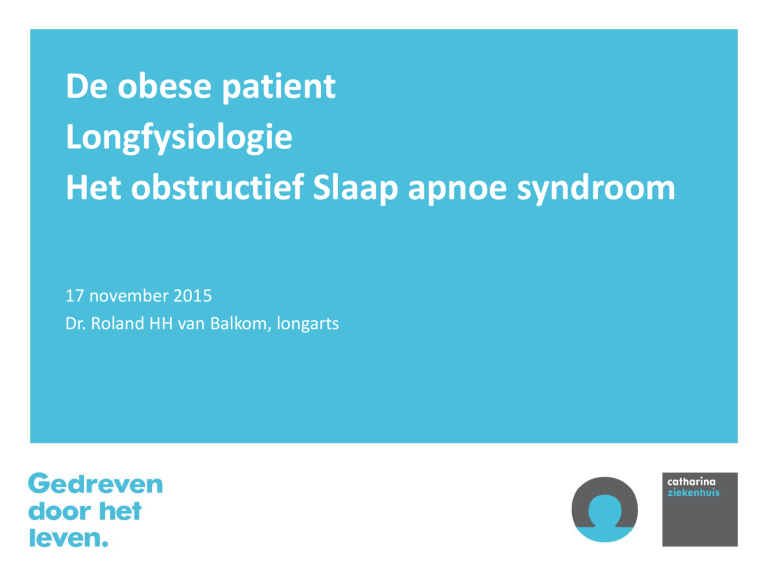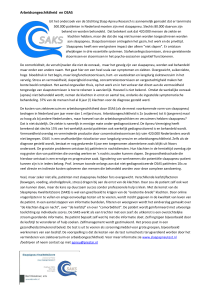
De obese patient
Longfysiologie
Het obstructief Slaap apnoe syndroom
17 november 2015
Dr. Roland HH van Balkom, longarts
Inhoud
•
•
Longfysiologie bij de obese patient
Obstructief slaap apnoe syndroom
• Incidentie
• Diagnostiek
• Behandeling
• Risico’s algemeen
• Risico’s bij de cardiaal belaste patient
Obsesitas
longfysiologie
Optimizing respiratory function assessments to elucidate the
impact of obesity on respiratory health
DANNY J. BRAZZALE,1,2 JEFFREY J. PRETTO,2,3 AND LINDA M. SCHACHTER4
Figure 1 (a) Static lung volumes in
obesity (OB) versus normal weight (NW)
showing a reduction in ERV and FRC. (b) A
typical flow–volume loop in an obese
patient showing a right-ward shift in the
tidal flow–volume loop, with a suggestion
of airflow limitation during tidal breathing.
Reproduced with permission from
O‘Donnell et al.11 Normal weight;
Obese.
Optimizing respiratory function assessments to elucidate the
impact of obesity on respiratory health
DANNY J. BRAZZALE,1,2 JEFFREY J. PRETTO,2,3 AND LINDA M. SCHACHTER4
Figure 1 (a) Static lung volumes in
obesity (OB) versus normal weight (NW)
showing a reduction in ERV and FRC. (b) A
typical flow–volume loop in an obese
patient showing a right-ward shift in the
tidal flow–volume loop, with a suggestion
of airflow limitation during tidal breathing.
Reproduced with permission from
O‘Donnell et al.11 Normal weight;
Obese.
Longfunctie verandering tijdens
anaesthesie
-
FRC afname van 50% ivm 20% reduction bij nonobese
Afname van de totale respiratoire compliance
- Afname thoraxwand compliantie
- Afname longcompliantie
- Sneller ademhaling
- Toename ademarbeid
- Afname van maximale ventilatoire capaciteit
Aanbevelingen voor Intraoperatieve
ventilatie bij obesen
Respiratory consequences of obesity:
conclusies
Decreased compliance (chest wall >> lung)
Increased airway resistance
Increased work of breathing
Respiratory muscle dysfunction
Ventilation perfusion inequality
Alterations in gas exchange
10
Hoe herkent u een OSAS
11
Slaapapneu: Indeling
Obstructief slaap apnoe syndroom (OSAS)
Centraal slaap apnoe syndroom (CSAS)
Gemengd slaap apnoe syndroom
Wat is een Apneu ?
• A = niet
• pnoea = ademen
• Apneu betekent dus: niet ademen
Wanneer spreken we van een OSAS
Onverklaarde buitensporige slaperigheid overdag
of tenminste 2 andere klachten (bv moeheid en concentratiestoornissen)
EN
AHI van tenminste 5 per uur
- apneus (A)
- of hypopnoes (H)
- of verstoringen van de slaap door de ademhaling (RERA)
OSAS: wat gebeurt er?
Moment van luchtwegcollaps
(Morrell, AJRCCM 1998;158:1974-1981
15
Historie
400 v.Chr. Dionysius
1830 Pickwick Papers
Hoe vaak komt OSAS
voor?
•Met name tussen 45 en 75 jaar
•Man: 1 - 7%
•Vrouw: 0.5 - 1%
Wat zijn de risicofactoren voor het
krijgen/hebben van een OSAS?
•
•
•
•
•
•
Overgewicht
Alcohol en kalmeringsmiddelen
Geslacht
Rookgewoonte
Hart problemen
Familiar
I
Klachten
zwaar snurken
wakker schrikken met verstikkingsgevoelens
ochtendhoofdpijn
slaperigheid overdag
vaak even in slaap vallen
ochtendmoeheid
grote moeheid overdag
concentratieverlies
vergeetachtigheid
nachtzweten
moeite met wakker blijven
droge mond bij het ontwaken
beklemmend gevoel op de borst
hyperventilatie aanvallen
verminderde zin in seks en/of impotentie
Het stellen van de diagnose
Het verhaal van de patiënt:
• Snurken
• Moeheid
• In slaap vallen
• Concentratie stoornissen
Het verhaal van de partner:
• Nachtelijke onrust
• Stoppen met ademen
• Snel geïrriteerd
• Depressief
Mallampati
Diagnostiek
Polysomnografie (slaaponderzoek):
• EEG/EMG/EOG
• luchtstroom
• Buik/borst beweging
• Zuurstof verzadiging
• Hartslag
• Decibel meter
• Positie meter
Diagnostiek
Polysomnografie (slaaponderzoek):
• EEG/EMG/EOG
• luchtstroom
• Buik/borst beweging
• Zuurstof verzadiging
• Hartslag
• Decibel meter
• Positie meter
Diagnostiek
AHI>5 + klachten!!
- AHI 5-15= licht OSAS
- AHI 15-30 = matig OSAS
- AHI > 30 = ernstig OSAS
Therapie bij OSAS
• Algemene/conservatieve maatregelen
• MRA (mandibulair repositie apparaat) =(beugel) bij
licht en matig OSAS
• Positie training bij houdingingsafhankelijk OSAS
• CPAP (continuous positive airway pressure) bij
ernstig OSAS of indien MRA geen optie is
• Operatieve ingrepen
Behandeling van OSAS: conservatief
afvallen
alcohol verminderen
stop roken
stoppen sedativa
zijligging
29
Behandeling van OSAS: conservatief
vermijden van rugligging
30
Night Shift
Behandeling van OSAS:
CPAP
Continues positive airway presure
32
CPAP
33
CPAP is maatwerk
34
CPAP
Nieuwe behandelmethodes
36
Nieuwe behandelmethodes of
toekomstmuziek
37
OSAS bij hartfalen
Behandeling OSAS bij hartfalen
Risco’s voor patienten met OSAS
40
Risco’s voor patienten met OSAS
41
Risco’s voor patienten met OSAS
42
Behandeling OSAS bij hartfalen
Kaneko; NEJM 2003
N=24 (50% non-ischemisch)
LVEF ± 27%
AHI ± 40/h
ESS ± 7
M/V 21/3
BMI ± 31
Behandeling OSAS bij hartfalen
Kaneko; NEJM 2003
Na 7 weken CPAP behandeling
Verklaring verschil acuut en chronisch
effect
Acuut effect:Toename intrathoracale druk
– Afname van systemische veneuze return
– Toename van pulmonale vaatweerstand
– Toename RV aferload
– Afname RV SV
– Daardoor afname LV preload en SV
– Echter wel een daling van de LV afterload
Verklaring verschil acuut en chronisch
effect
Chronisch effect:
Afname van sympathische activiteit
Grote rol voor systemische vasculaire weerstand
Rol van hypoxie
Het effect van CPAP behandeling is mogelijk gerelateerd aan de hoogte van de sympathische
activiteit en SVRI
Risco’s voor patienten met OSAS
50
Obesitas hypoventilatie syndroom
51
Conclusies
OSAS is een veel voorkomend
gezondheidsprobleem (♂:4%, ♀:1%)
OSAS vergroot het risico op hypertensie,
atherosclerose, CAD en aritmieën
Zeer hoge prevalentie van zowel CSAS als OSAS
bij patiënten met een CHF (♀:47%, ♂:75%)
Intubatie risico












